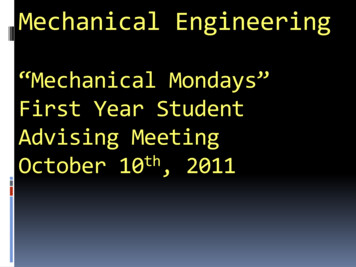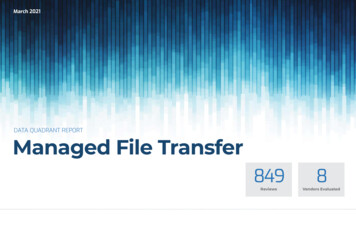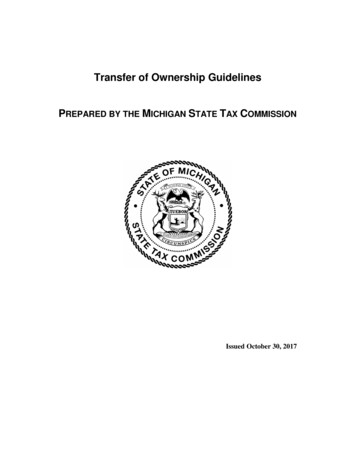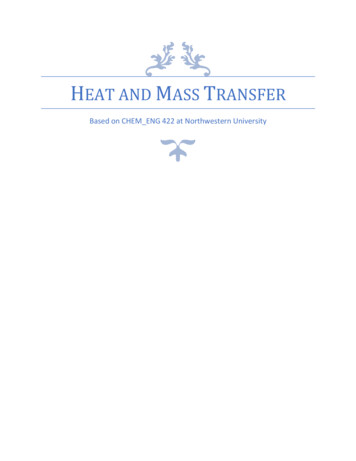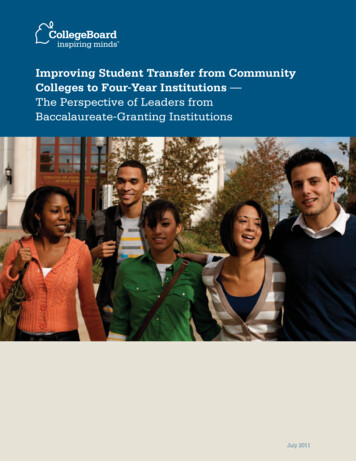
Transcription
Transfer and the Four-Year InstitutionImproving Student Transfer from CommunityColleges to Four-Year Institutions —The Perspective of Leaders fromBaccalaureate-Granting InstitutionsJuly 2011
The College BoardThe College Board is a mission-driven not-for-profit organization that connects students to collegesuccess and opportunity. Founded in 1900, the College Board was created to expand access to highereducation. Today, the membership association is made up of more than 5,900 of the world’s leadingeducational institutions and is dedicated to promoting excellence and equity in education. Each year,the College Board helps more than seven million students prepare for a successful transition to collegethrough programs and services in college readiness and college success — including the SATR andthe Advanced Placement Program . The organization also serves the education community throughresearch and advocacy on behalf of students, educators and schools.For further information, visit www.collegeboard.org.
Improving Student Transferfrom Community Colleges toFour-Year Institutions —The Perspective of Leaders fromBaccalaureate-Granting Institutions
Project DescriptionTwenty-one higher education leaders were interviewed at 12 four-year institutions that are known for theircommitment to transfer students; these leaders possess expertise in one or more facets of institutionaladministration, including outreach and recruitment, admission and enrollment, financial aid, and student andacademic affairs. (The names, titles, and affiliations of these individuals are presented in Appendix 1.) Theseleaders were sent in advance a list of questions to be addressed during the interview. The questions focusedon their work with transfer students in a variety of areas, including recruitment, enrollment planning, financialaid, and student and academic affairs. All interviews were taped and transcribed. This report reflects only asmall portion of the entire set of conversations.This project was conceived by Stephen J. Handel of the College Board, who also conducted the interviewsand wrote this report.Every attempt has been made to present as accurately as possible the views of the individuals whoparticipated in this project, although their comments do not necessarily represent those of the College Boardor its member institutions. Any errors, however, are the responsibility of the author.AcknowledgmentsThis report would not have been possible without the help of the individuals listed in Appendix 1. They couldnot have been more supportive in providing their time and insights about the transfer process in the UnitedStates and the role of their institutions in enrolling and educating students from public community colleges.At the College Board, the author benefited from the advice and counsel of colleagues throughout theorganization, including Peter Negroni, Ronald Williams, Alan Heaps, and Adam Hillier. The expert productionteam included Leanne Snoeck (project management), Tylor Durand (design), Bill Tully and Suellen Leavy(desktop and layout), and Kiki Black, Carolyn Alexander and Lori Bednar (editorial review). The author isespecially thankful to James Montoya for his guidance and support of this project.For additional copies of this report or information about the College Board’s community college initiatives, visit:www.collegeboard.com/communitycollege.
Transfer and the Four-Year InstitutionTable of ContentsPreface. .4Part 1: Why Transfer? Why Now?.6Part 2: Developing a Strategic Focus and Something More —Authentic Commitment. .8Part 3: Reaching Out to Community College Transfer Students —It’s Harder Than it Looks. 11Part 4: Admitting and Enrolling Community College TransferStudents — Taking the Plunge. . 16Part 5: Providing Financial Aid to Community College TransferStudents — It’s Not Just the Money. 20Part 6: Creating a Transfer Receptive Culture — Honoring thePresence and Contributions of Community CollegeTransfer Students. 23Part 7: Parting Thoughts — Looking Ahead. 28Appendix 1: Interview Participants. . 30Appendix 2: Summary and Recommendations. 32Endnotes. 34
PREFACE“Transfer students are proven. You’re nottaking a chance with them. Once theycome to a four-year institution you knowthey want a degree. Transfer students area great investment.”Frank Ashley, Texas A&M University SystemAs the nation prepares to meet President Obama’sgoal of eight million new college graduates by2020, the transfer process — the pathway betweencommunity colleges and four-year institutions — willtake on an increasingly vital role. For many four-yearcolleges and universities, however, this pathway isuncharted territory. To help clear a path, this reporthighlights the perspective of four-year institutionleaders who have had success in recruiting, enrollingand serving transfer students. It is hoped thattheir insights will assist other four-year college anduniversity leaders who wish to enroll and educatetransfer students from community colleges.While the transfer process has garnered the attentionof researchers for many decades, much of theirwork is focused on the challenges facing two-yearinstitutions. Relatively little attention has been paidto the role of four-year colleges and universities. Yetthese four-year institutions, both public and private,are responsible for admitting transfer students,evaluating and accepting students’ course credits,and awarding financial aid. Four-year colleges anduniversities represent the pivotal gatekeepersin the transfer pathway, although they haverarely asserted their role in the transfer process.Recent events — a bruising recession, internationalcompetition and long-predicted demographic shiftsnow evident — have created an urgency among theseinstitutions to investigate the viability and the longterm merit of a more efficient transfer system.This report begins to redress this imbalance by givinggreater voice to the four-year institution perspectiveby interviewing institutional leaders who areconcerned with and committed to the needs of thecommunity college transfer student.4Without properly consulting with the institutionsthat award the baccalaureate degree, the transferprocess can never function in a way that supportsthe nation’s need for an educated citizenry — inparticular, a citizenry that authentically representsthe diversity of this nation.What follows is their assessment of the transferprocess in the United States, the challenges theyface — institutional, academic and programmatic —in serving transfer students and, most importantly,their perspective on the opportunities that accrue toa four-year institution that makes community collegestudents an essential part of its campus community.Twenty-one higher education leaders wereinterviewed at 12 four-year institutions that are knownfor their commitment to community college transferstudents (see Appendix 1). Their institutions includepublic and private colleges and universities, publicflagship and smaller institutions (including a private,liberal arts institution), and highly selective andmoderately selective universities (see sidebar, p. 5).Of course, 12 institutions represent only a fraction ofthe colleges and universities that recruit, admit andserve transfer students in the United States. But thepurpose of this effort was not to inventory the workof every four-year institution, but to highlight the workof representative schools engaged successfully in thiswork. Any four-year leader interested in expanding thetransfer efforts of his or her campus would be welladvised to consult with individuals who took the timeto participate in this initiative, as well as leaders ofany of the nearly 100 institutions listed by U.S. News& World Report as enrolling high numbers of transferstudents.1One final point: This report is only concerned withstudents attending public community colleges whotransfer to a four-year institution with the intentionof earning the baccalaureate degree. There are,of course, other kinds of students who transfer,particularly those who move from one four-yearinstitution to another. The needs of those studentsare not addressed here, even though many of theinstitutions that were visited for this project enrollsignificant numbers of four-year transfer students.In theory, these students, sometimes called lateraltransfers, could earn a degree from their original fouryear institution but, for whatever reason, have chosen
Transfer and the Four-Year Institutionto go elsewhere. The community college transferstudent, however, must transfer to an upper-divisioninstitution or the student will never earn a bachelor’sdegree. Students who enroll in a community collegehave entered into an agreement — sometimesformally, but most of the time only implied — thatthey will be allowed to finish their bachelor’s degreesomeplace else.Four-Year Institutions Profiled in This ReportGeorgetown University, District of ColumbiaUniversity of Central FloridaIowa State UniversityThe University of North Carolina, Chapel HillSyracuse University, New YorkUniversity of North TexasTexas A&M UniversityUniversity of Southern CaliforniaThe University of ArizonaVirginia TechUniversity of California, Los AngelesWheaton College, Massachusetts5
PART 1Why Transfer? Why Now?“I think it’s an advantageous time forfour-year schools to start thinking abouthow their enrollment goals and theirenvironment might be enhanced byconsidering transfer students.”Jerry Lucido, University of Southern CaliforniaMost four-year colleges and universities in the UnitedStates admit transfer students in some fashion. Few,however, have made community college students anintegral part of their overall enrollment managementstrategy. The main reason appears to be a beliefby many four-year institution leaders that there isan inexhaustible supply of high school graduatesto recruit. But there are other reasons as well. Forexample, at smaller liberal arts colleges, which haveanchored their institutions in a tightly structuredfour-year curriculum, enrolling community collegestudents is difficult because there are few entrées forlatecomers. Larger institutions, especially public fouryear universities, manage to admit community collegetransfers, even relatively large numbers of them, butthe effort is sometimes lackluster, a bow more topolitical pressure than a conscious decision to servetransfers with the same level of commitment they dofor freshmen. Other four-year universities, especiallythose in the Southwest, are earnestly committedto reaching out to Native American students whoattend two-year tribal colleges, but their efforts arechallenged by the remoteness of some colleges andthe reluctance of students to leave their families andhomeland (a not dissimilar concern of students fromother underserved groups).Whatever the reason for avoiding transfer students,public community colleges — and the studentsthey serve — have an increasing visibility amongpolicymakers who see these institutions as servinggreater numbers of students at a lower cost. Theyare also becoming more popular among studentsand parents who are anxious to extend their highereducation resources in the face of rising four-yearcollege tuitions and academic competition. Moreover,6the college-going population is changing. Accordingto the Western Interstate Commission for HigherEducation (WICHE), the number of public high schoolgraduates is expected to decline, reaching its lowestpoint in 2013-14.2 Highlighting this volatile confluenceof variables, a Brookings Institution study recentlyconcluded, “Confronted with high tuition costs [atfour-year institutions], a weak economy, and increasedcompetition for admission to four-year colleges,students today are more likely than at any other pointin history to choose to attend a community college”[emphasis added].3Consider the following: Community colleges are the largestpostsecondary education segment andits share of the undergraduate populationis likely to increase: Community collegesenroll more than seven million students,nearly 44 percent of all undergraduates in theUnited States.4 In the 2007-08 academic year,community colleges enrollment hit an all-timehigh, especially among traditional collegeaged students (18–24 years). In comparison,enrollments at four-year institutions were flat.More remarkably, among all 18-to-24-year-oldsin the United States, one student in 10 wasattending a community college.5 Community college students want totransfer: Transfer has been and continues to bea popular goal for a large proportion of incomingcommunity college students. Surveys indicatethat at least 50 percent and perhaps as many as80 percent of all incoming community collegestudents seek to transfer and earn a bachelor’sdegree.6 Moreover, many students whointend to earn sub-baccalaureate credentialsat a community college often increase theireducational aspirations after starting at a twoyear college.7 Community colleges will prepare morestudents for transfer in the future, especiallystudents from middle-class backgrounds: TheAmerican Association of Community Colleges(AACC) estimates that between 2007 and 2009,the number of full-time students enrolled incommunity colleges grew 24 percent.8 And,as noted above, significant overall growth in
Transfer and the Four-Year Institutioncommunity college enrollment has been fueledlargely by traditional-age students (18–24 years).Traditional-age students attending full timeare far more likely than other students to havetransfer and the bachelor’s degree as a goal. Community colleges attract students fromunderserved groups in greater numbersthan four-year colleges and universities:White students dominate community collegeenrollments as they do in four-year institutions.Compared to four-year institutions, however,community colleges enroll greater proportions ofAfrican American, Hispanic, and first-generationstudents, as well as students from the lowestincome level and single-parent families.9 Theserelative proportions are likely to increase since,for example, the population of students fromunderrepresented ethnic groups is expected toincrease substantially in the coming decades.10Moreover, students from underserved groups,especially Hispanic and Native Americanstudents, have traditionally enrolled incommunity colleges in greater numbers than inpublic four-year institutions, regardless of theirincome level.11Appreciating that community colleges offer a hostof advantages to first-time students — advantagesthat four-year institutions are finding difficult tomatch — Frank Ashley, vice chancellor for academicaffairs at the Texas A&M University System, recallsthe advice he gave his staff when he supervisedadmissions at Texas A&M–Commerce: “Listen guys,we can’t compete against the cost of the communitycollege or their numerous locations. We should reallyconcentrate our [outreach] funds toward recruitingtransfer students ”As four-year institution leaders like Frank Ashley willattest in the following pages, the higher educationmarketplace is changing, and transfer students will bean important and permanent part of it. Community colleges cost less to attendthan four-year institutions: The cost ofcollege is rising at two- and four-year collegesand universities, just not as fast or as much atcommunity colleges. According to data compiledby the College Board and AACC, tuition andfees at community colleges average only 36.2percent of the average four-year public collegetuition and fee bill.12 Community colleges are more accessiblethan four-year institutions: According to AACC,there is a community college located withindriving distance of most Americans. Moreover,community colleges are more evenly distributedcompared to four-year institutions. Twenty-ninepercent of community colleges are located incities, 24 percent in towns and 18 percent inrural areas.13 In a recent survey of students,proximity was a major reason why they selectedone school over another.147
PART 2Developing a StrategicFocus and Something More— Authentic Commitment“Who is truly the voice for transferstudents at your institution? Who areyour champions? Is there an institutionalcommitment to transfer students? Is it apart of the institution’s values? If it is not,you’re just spinning your wheels.”Marc Harding, Iowa State UniversityThe higher education leaders interviewed for thisproject stressed that a serious commitment toenroll and serve transfer students from communitycolleges cannot be a separate initiative, parked alonga sidetrack, while the institution fulfills its mission onthe main line. Minimally, the institution must valuetransfer students by including them as part of itsstrategic enrollment plan and, ideally, at the core of itsinstitutional mission. If a four-year college or universitydoes not foster an institution-wide appreciation oftransfer students as full-fledged members of thecampus community, their presence serves neitherthe student nor the institution well. Mark Allen Poisel,associate vice president for student developmentand enrollment services at the University of CentralFlorida,15 describes the problem:What happens, especially in large institutions,but throughout the country, is that transferstudents are treated as second-class citizens.Intentionally or not, people design programsaround freshmen. At the University of CentralFlorida, we value freshmen, but we valuetransfers too, understanding that sometimesour efforts might have to be the same, butsometimes might have to be different.Many of the higher education leaders interviewedfor this report make a distinction between a tacticalcommitment to transfer students and a strategicone. The former being an opportunistic approach that8sees the enrollment of transfer students as the onlyaim; and the latter approach that views the educationof transfer students as a broader commitment,encompassing enrollment and service to thesestudents after they matriculate at the four-yearinstitution.Without a long-term, strategic commitment,several leaders candidly argue that an institution’scommitment to transfer students is nothing morethan a mercenary process designed to enroll studentsas backfill for an otherwise unsuccessful freshmanrecruitment season.“I think at some institutions there’s a seriousorientation toward transfer students to balance theledgers,” says Marc Cutright, associate professor ofhigher education at the University of North Texas.Including transfers as part of its institutional missionallows faculty and staff to plan for these studentswith the same seriousness of effort that an institutionapproaches admission of first-time college students.This is necessary because transfer students presentfour-year colleges and universities with a series ofchallenges in almost all facets of the institution.Youlonda Copeland-Morgan, associate vice presidentfor enrollment management at Syracuse University,remarks: “I think Syracuse is in the same placethat every other institution finds itself: Strugglingto determine the right number of transfer studentsand assessing how this number will impact housing,advising, financial aid and the curriculum.”Unless these and other areas are addressed, aninstitution may increase enrollment of transfers in theshort term, only to lose them later through attritionand indifference, as noted by Laura Doering, directorof transfer relations at Iowa State University: “Wecan’t sustain our enrollment of transfer studentswithout getting them to graduation.”What Transfer Students Bring to theFour-Year CampusFor colleges struggling with whether the enrollmentof community college students should be a part oftheir institutional future, experts agree that thesestudents offer a number of advantages to thecampus community. First, transfer students play animportant role in diversifying a campus, a strategic
Transfer and the Four-Year Institutiongoal of almost all higher education institutions. AlfredHerrera, assistant vice provost at the University ofCalifornia–Los Angeles, explains:The obvious advantage in admitting transferstudents is that you obtain representation ofstudents from different communities who havedifferent life experiences. I think one of the goalsof higher education is to prepare students tocompete and perform well in the real world — tobe able to change that world in ways that matter.Having students come from a variety of areas —whether it is geographic, cultural, ethnic, age —is a critical factor in that preparation.Transfer students bring diversity primarily becausepublic community colleges enroll more students fromunderserved groups than any other higher educationentity. The low cost, open admission and proximityof community colleges make them accessible tothe widest variety of students in American society.Of the seven million community college studentscurrently enrolled in for-credit courses, 42 percent arethe first in their family to attend college, 46 percentare receiving financial aid and 45 percent are from anunderrepresented ethnic minority group.16 This accesshas been especially important to students fromunderserved groups, which will constitute an everlarger share of the American population in the comingdecades. Youlonda Copeland-Morgan summarizesthis trend:When we pay attention to the changingdemographics of our students in our communityand the rest of the country, the importance ofcommunity colleges becomes obvious. I meanyou really have to be walking around with youreyes closed not to see this.This changing demographic has implications foralmost all higher education institutions, but plays outin different ways around the country. In some regions— the West and the Southwest in particular — thenumber of students wanting a college education isexploding, due mainly to the rising number of collegeage Latino students who begin their education atcommunity colleges. In Texas, which has one of thehighest proportions of Latino students in the UnitedStates, the community college is playing a pivotal rolein the statewide “Closing the Gaps” initiative, whichis designed to increase the academic achievement ofall underserved students. According to Bonita Jacobs,executive director of the National Institute for theStudy of Transfer Students at the University of NorthTexas.17 “Transfers are our bread and butter. If weignore the transfer population, there is no way thestate will meet its Closing the Gaps goals.”In other regions of the country, four-year institutionsare preparing for a static or lower high schoolgraduation rate. This is especially true in the Midwestand New England. Students in community collegesbecome attractive as a pipeline to maintain orincrease current enrollment levels. Yet all of theleaders interviewed for this project, regardless of theirfunctional area, identified the importance of transferstudents in terms more global than the immediateenrollment needs of their institutions.“We made a decision very early that we were notgoing to enroll more transfers as a numbers gameand partner only with our largest feeder communitycolleges. We see this as long-term relationshipbuilding,” says Marc Harding, assistant vice presidentfor enrollment and director of admissions at IowaState University.Moreover, although not all institutions in this reporthave a land-grant mission, most representativesspoke largely in land-grant terms, stressing howthe enrollment of transfers serves not only theinstitution but also their communities and the nation.Jerry Lucido, executive director of the Center forEnrollment Research, Policy, and Practice at theUniversity of Southern California, one of that state’slargest private institutions, noted, “Serving transferstudents serves USC’s interest certainly in itsenrollment functions, but it also serves social goalsin transforming our area and Los Angeles.In some ways, USC functions almost as a privateland-grant university.”Iowa State University, one of the nation’s largestpublic institutions, has made a significant effort inthe last decade to increase the number of studentsthat it enrolls from Iowa’s community colleges.Although part of this initiative was driven by the needto maintain enrollment in a state with a projecteddecline in high school graduates, the most significantimpetus was to reach out more broadly to the citizensof Iowa.9
“We are a land-grant university, and we should bereaching out to community colleges and doing itbetter than anyone else,” says Marc Harding.The University of Arizona, also a land-grant institution,understands that it has a special responsibility toserve the state’s constituents. “About 36 percentof the land base in Arizona is tribal land. We have aresponsibility to reach out to those students,” saysKaren Francis-Begay, special advisor to the presidenton Native American affairs.The final and most important advantage of transferstudents is that most are good students. In fact, allof the higher education leaders interviewed for thisreport emphasized that transfer students perform wellat their institutions and are at least as accomplishedas their first-year students, sometimes more so.Angela Peterson, associate vice president for regionalcampuses at the University of Central Florida,notes that of the 10 outstanding senior awards UCFawarded last winter, seven were communitycollege transfers.Patricia McWade, dean of student financial aidservices at Georgetown University says, “We havea very high graduation rate for transfer students.They graduate with distinction.”Janina Montero, vice chancellor for student affairs atUCLA, concurs, “Transfer students bring a focus totheir academic work and they graduate at the samerate as our freshmen. Our transfers participate in allof our academic departments. They are really spreadacross all majors.”Summing up the advantages that transfer studentsbring to the four-year institution, Stephen Farmer,director of admission at the University of NorthCarolina–Chapel Hill, stresses that “enrolling transferstudents is not charity.”The Role of Institutional LeadershipThe experts agreed that a commitment to recruit,enroll and serve transfer students requires vision fromadministrative and faculty leadership. At GeorgetownUniversity, transfer students have been an importantpart of the student body for two decades. Accordingto Patricia McWade, this came about as the result ofthe leadership of Father Timothy Healy, who led theinstitution from 1976 to 1989. “Father Healy had a10vision back then to enroll students from communitycolleges,” she says. A transfer plan soon followed,providing an important gateway for communitycollege students to attend an elite four-year institution.Leadership alone, while essential, is not enough,however. The experts agreed that a broaderconsensus must be formed.“One of the problems in getting people to grabhold of the transfer issue is that we don’t talk aboutit with senior staff,” says Copeland-Morgan. Sheacknowledges that institutions are complex placesand that staff are busy and sometimes distracted, but“enrollment is one of the pillars of the institution” andshould be the concern of leaders throughoutthe university.Leadership, especially in dealing with transferstudents, should not be a one-way conversation.“There was so little that we knew when we beganour work with community college transfers,says Steve Farmer. “We approached it from theposition of abject humility. Instead of trying totell the world how to do it our way, we developedsome partnerships with community collegecolleagues who could help us.”Leadership also is needed from community colleges.Bringing leaders together — faculty, staff andstudents — helps establish and maintain these pivotalinterinstitutional partnerships. Alfred Herrera notesthat UCLA’s chancellor, for example, regularly visitscommunity colleges throughout California, and hebrings a team with him, including senior staff fromadmissions and student and academic affairs.In Florida, leaders of two- and four-year institutionscreated the College Access Initiative (www.collegeaccess.ucf.edu), which focuses on providingaccess to bachelor’s degrees to the Central Floridaregion. Transfer is an essential part of this initiative,with special attention to curriculum alignment fromK–12 through higher education.“It’s about what we can do as a region that wecannot do independently,” says Angela Peterson, fromthe University of Central Florida.18
Transfer and the Four-Year InstitutionPART 3Reaching Out toCommunity CollegeTransfer Students — It’sHarder Than It Looks“If you are going to recruit transferstudents, you have to invest the time andthe staff to do it.”Mildred R. Johnson, Virginia TechReaching out to transfer students presents a uniqueset of outreach and recruitment challenges, differingsignificantly from those used to recruit freshmanstudents. First, there is the problem of findingqualified students ready to transfer. Unlike high schoolcohorts that begin and en
For many four-year colleges and universities, however, this pathway is uncharted territory. To help clear a path, this report highlights the perspective of four-year institution leaders who have had success in recruiting, enrolling and serving transfer students. It is hoped that their insights will assist other four-year college and


